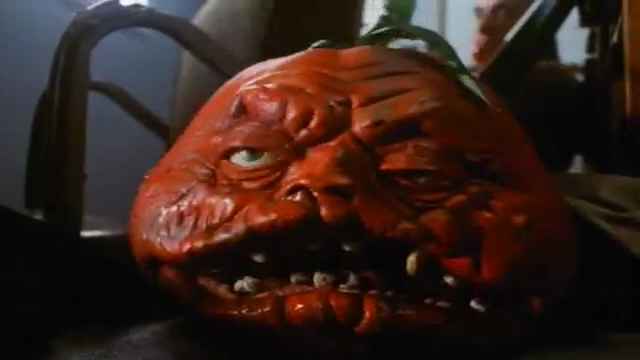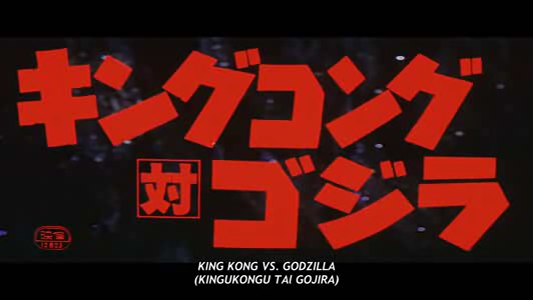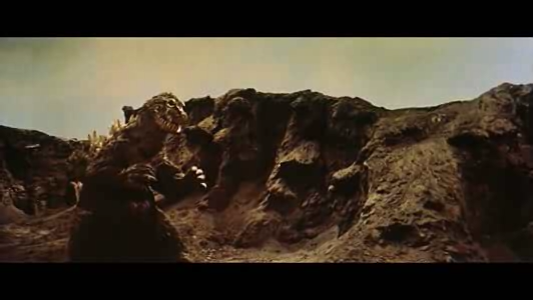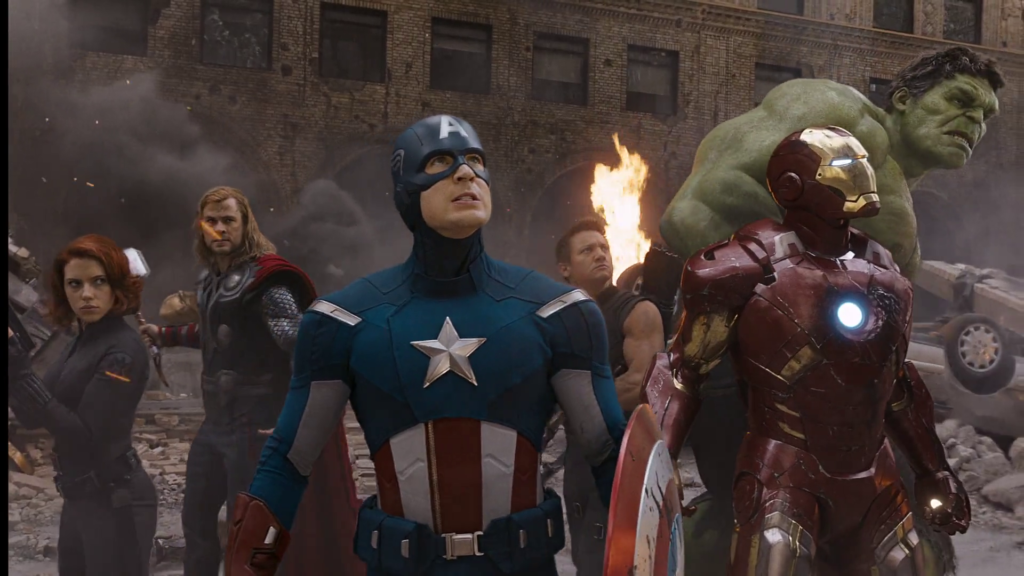-
#339 – Killer Tomatoes Eat France (1991)
Killer Tomatoes Eat France (1991)
Film review #339
dir. John De Bello
SYNOPSIS: Professor Gangreen has escaped from prison and intends to enact a new plan to take over the world using his killer tomatoes. This time he intends to fulfil an ancient French prophecy to install his assistant Igor to the throne of France. An American backpacker arrives in France and stumbles upon Gangreen’s sinister plan, and with Marie, a local French villager, and FT (Fuzzy Tomato), a “good” tomato, they must work together to stop Gangreen before he fulfils the ancient prophecy…
THOUGHT/ANALYSIS: Killer Tomatoes Eat France is a 1991 film and the fourthin the Killer Tomatoes film series. Let’s start off with the title of the film: it wouldn’t sound halfway believable if there wasn’t already a well-established franchise consisting of four films, a cartoon series and video games that constantly parodies the b-movie monster genre. The film right from the outset presents the viewer with some silly credits that while not wholly original, might get a small chuckle or two. This is accompanied by a very dramatic and orchestral arrangement of the “Attack of the Killer Tomatoes” song, which is massively overproduced for a b-movie project like this, but that’s definitely part of its charm. I think this was also used in the previous films too, but it’s been a while since I’ve seen them. The film starts properly with Professor Gangreen, the creator of the killer tomatoes, about to face execution in France, when he is rescued by his assistant Igor. Gangreen then hatches yet another plan to take over the world using his killer tomatoes, intending to fulfil an ancient prophecy of the return of a French King, and having Igor be that King. The film’s story is rather simple, with plot points parodying other stories, so it’s easy to follow. It’s obviously not meant to be an epic tale, but pokes fun at all of the tropes that it incorporates into its story.
Meanwhile, an American backpacker is travelling through France when he meets a young French woman named Marie. She learns he is an actor, although she doesn’t learn that he is a b-movie actor…hence this film, and he introduces himself as Michael J. Fox to try and impress her. I’m not sure if Michael is supposed to be his actual name, because it’s never really revealed, so we’ll just go with it. The country of France is probably the butt of most of the jokes in this film, with it portraying rural France as living in the 1800s, and the various stereotypes of the French, from eating snails to the various traits made popular by actor Jerry Lewis. It is a completely over-the-top characterisation that may feel a little old fashioned nowadays, but provides some funny slapstick moments, such as the French army facing off against the tomatoes by launching baguettes at them. There’s also the plot element concerning the prophecy of a king returning to the throne of France, and the film depicting the need of France to have a monarch again after they became a republic. Probably not the best depiction of French values, but there is a note in the credits that basically says not to take it too seriously, and the film itself reflects that rather well. The film basically continues the world established in the previous films, where tomatoes were banned worldwide and everyone uses rather gross alternatives for tomatoes in their food. France is established as the only place in the world where tomatoes and humans live alongside each other in harmony. Killer Tomatoes Eat France does distinguish itself from the others by having sentient vegetables that weren’t created by Gangreen, and also giving some of the tomatoes speech, which they never did previously. It is in contradiction with the world established by the previous films, but it’s a world with killer tomatoes in it, and it’s not a film series that focuses on consistent world-building.
The rest of the characters include the return of Professor Gangreen and his assistant Igor from the previous films, who created the killer tomatoes. They get a lot of focus in the film and their general incompetence sets up a lot of the jokes. There is also F.T. (Fuzzy Tomato), the only ‘good’ tomato that Professor Gangreen created, who is performing a concert at the Louvre and helps to stop Gangreen and his scheme. There’s also Louis XVII (who says he always wondered why his last name was “17″), who learns he is the true King of France, and who Michael and Marie must restore to the throne in place of Igor. Gangreen and Igor are also helped by three tomato minions (Zoltan, Kethuck and Viper), who are based on characters from the cartoon series. It’s a packed cast who all fulfil specific roles, so there’s not much to complain about in that regard.
The whole film feels a lot more child-friendly than the previous films: maybe because it was riding on the back of the cartoon series, which was mildly successful. A lot of the jokes lack any teeth and would probably appeal to a child’s sense of humour, but are devoid of much more substance for adults to enjoy (although Gangreen being marches to the guillotine at the beginning is a little dark). A lot of the jokes break the fourth-wall and extend onto the set of the film, and while the previous films did some of this, it does happen a bit too much here. The best gags are the more subtle ones, such as during the war scene, where green army men toy figures are used to create a mock special effect of a real army charging across the battlefield, only for the film to cut to an actual field and life-sized green army men are actually stood in the field, this gaga also continues with toy tanks, and the way the film switches between toys and real-life is well done. Other visual gags such as the French soldiers wielding baguettes as weapons and Gangreen deploying banana skins and marbles on the tower stairs that Michael is trying to climb to rescue Marie. The film doesn’t have a huge budget, but still manages to pull off some big scenes, such as the battle mimicking the trenches of the first world war, and the car chase through the streets of Paris. Killer Tomatoes Eat France doesn’t add anything new to the world of killer vegetables, instead just providing more of the same as we have seen before. It changes things up with setting it in a caricature of France that is out-of-date and overly cartoonish, but nevertheless provides a few funny moments. Some of the humour, while not overly original, keeps the film afloat and form being a boring experience. The trouble is the first film started out as a parody of b-movie horror films, and with the fourth film there’s not too much left to parody (hence why there’s more focus in parodying France). The b-movie genre by 1991 was also long gone, and so the film exists in this non-space where it is referencing things which aren’t really relevant. However as I mentioned at the beginning, there’s something about this series that kept it going, and the film, for better or worse, manages to continue this bizarre franchise.
-
#338 – King Kong vs Godzilla (1962)
King Kong vs Godzilla (1962)
Film review #338
dir. Ishirō Honda
SYNOPSIS: Pacific Pharmaceuticals are having trouble coming up with some successful advertising. Mr. Tako, the head of the company, is told about a monster that exists on a remote island, and sends Sakurai and Kinsaburo, two of his employees, to capture it so he can use it as the new mascot for the company. However, another monster appears: Godzilla is back and goes on the rampage, and a plan is devised to bring Godzilla and this new monster, King Kong, together in the hopes they destroy each other before they destroy everything else…
THOUGHTS/ANALYSIS: King Kong vs Godzilla is a 1962 monster film and the third film in the Godzilla series. Given that King Kong is a Hollywood character, and Godzilla a product of Japanese cinema, this film is a true crossover of east vs west. The film starts off showing the failed marketing of Pacific Pharmaceuticals, and their boss Mr. Tako tearing his hair out trying to get attention for the company. A doctor tells Mr. Tako about a remote island in the South, where an indigenous tribe worships some kind of monster. Mr. Tako somehow concludes that getting this monster to advertise his products as a mascot would lead to the company dominating TV ratings, and so sends to marketers Sakurai and Kinsaburo to the island in order to capture the monster and bring it back to Japan. This monster turns out of course, to be King Kong, and the opening act of the film focuses on his origin story. It’s pretty similar to earlier incarnations in that King Kong is worshipped as a God by an indigenous tribe, who make various offerings to him. The film slowly builds up to his appearance then engages in a fight scene with a giant octopus (really just a regular-sized octopus on a model set), which establishes King Kong’s strength and showcases his power before the inevitable meeting with Godzilla. It doesn’t add much to the character of King Kong, but it doesn’t need to: some characters just don’t need to be more complex or have a motivation to smash stuff.
When King Kong is sedated and on the way back to Japan, Godzilla awakens from being trapped in ice, and heads off on the rampage. The Japanese Self Defense Force tries a number of operations to try and stop it, but all of them fail. The only option left to them is to get King Kong and Godzilla to meet and destroy each other. It should be noted that the whole tone of this film is a lot lighter than the previous two Godzilla films. The story being based around using these monsters in a war for TV ratings shifts the focus from the horrors of the destruction to more of a satirical look at human’s and corporation’s response to tragedy to use it to maximise attention and ratings. This ultimately makes the film a bit more goofy and silly than the original two films, which were very dark, and had powerful messages about Japan’s relationship to destruction and nuclear technology in the aftermath of the Hiroshima bomb. It’s not a bad move that the film takes, it’s just something different, and it is the direction the film series takes after this one to appeal more to younger viewers. Again, we get the basic plot points of King Kong condensed into this film, with him being captured, breaking loose, and going on a rampage in a city, while kidnapping a woman and climbing a tall building. The people that made this film clearly wanted to tell King Kong’s story in full, but also in their own way, making him feel almost at home in the setting of Japan, by which I mean trashing their cities…
When we eventually see King Kong and Godzila face off, Godzilla manages to overcome King Kong easily thanks to his atomic breath meaning King Kong cannot even get close. In their second meeting, King Kong fares better thanks to having absorbed electricity form power lines and an oncoming lightning storm: it is hinted that King Kong has the ability to summon storms and has an affinity with lightning, but it’s not explained very well. So while King Kong eventually emerges the winner in the end, Godzilla gets a victory as well, so it should satisfy both fans. Apparently King Kong was even more popular than Godzilla in Japan at the time, so having him win at the end obviously satisfies more people. The monsters are played as in previous Godzilla films by men in suits rampaging over model sets. The suits look decent, and the fighting is carefully choreographed, but does get a little silly at points, such as when they’re throwing rocks at each other. Some of the plans to deal with Godzilla are very cartoon-ish too, such as literally digging a pit and covering it up, so that Godzilla will fall down into it. Also airlifting King Kong by tying balloons to him looks pretty silly.
This is the first time we have seen Godzilla and King Kong in colour, since their previous films were in black and white too, and the addition of colour definitely makes them look less threatening anyway. One thing that stands out is Godzilla’s big eyes that are almost cartoon-like, whereas King Kong looks extremely messy and primal, which sets up a good contrast between the two. The effects are pretty decent, but there’s not as much destruction as the previous films, probably because over half the film’s budget went to securing the rights to use King Kong in the film. Overall though, while it is a little different in tone to previous Godzilla films, it changes things enough to keep it fresh, and is structured well to tell the story of two monsters alongside giving ample screen-time to both. Some people may not like the goofy human stuff, but all in all it’s a decent offering.
-
#337 – Marvel’s The Avengers (2012)
The Avengers (2012)
Film review #337
dir. Joss Whedon
SYNOPSIS: While S.H.I.E.L.D. is performing experiments on an object known as the tesseract, a potential source of unlimited energy, it is stolen by Loki, a demi-god who wishes to use it’s power to subjugate the human race. Nick Fury, the director of S.H.I.E.L.D., assembles a team of heroes to counter this new threat to Earth, but first they must learn to work together before they can take on Loki…
THOUGHTS/ANALYSIS: The Avengers (or Marvel’s The Avengers or Marvel Avengers Assemble) is a 2012 superhero film that is the culmination of the first series of films establishing the marvel cinematic universe. The previous films mostly dealt with the origins of the characters, while also providing hints about how they will fit into the wider universe. This film has the aim of bringing all these different superheroes together, with their own unique presence, powers, and personalities, and devising a way for them to work together as a team. It is certainly an ambitious project to cross-over all these different worlds and stories, requires a balance to get right with regards to using each character effectively.
The film starts off showing the S.H.I.E.L.D. agency conducting experiments on an object called “the tesseract”, which played a part in the Captain America film and briefly shown in the Thor film. They are trying to harness its power to produce a limitless source of energy. It suddenly springs to life and opens up a portal through which Loki, the antagonist from Thor, emerges. He takes control of the minds of a number of personnel, and escapes the facility with the tesseract. Nick Fury, the director of S.H.I.E.L.D., recognises the severity of the situation, and calls upon the various heroes to track down Loki and the tesseract. The film introduces each of the characters individually, so they are each explored on their own terms and their personal motivations are established firmly. The story structure is fairly standard, with a clear three-act structure that flows as you would expect, but there’s plenty of humour, action and story packed into them that the film nevertheless gives you everything you need. With a runtime of nearly two and a half hours, it’s a long one, but every scene is worthwhile in some way, and it could have probably got away with being even longer because there is so much potential with these characters and setting.
The characters have already been established through the previous films, primarily dealing with their origins and motivations that make them heroes. Even if you haven’t seen all of them, you get a pretty good idea of who they are and what drives the. Captain America comes across a heroic soldier who comes up with a strategy for battle, Iron Man/Stark is the guy with the resources who deflects criticism with his humour. Banner/The Hulk is the smarts who is also an unpredictable element, and Thor is a demi-God out to stop his Brother. Black Widow/Romanoff and Hawkeye/Barton did not have their own films, but appeared in the others so they are somewhat established, but Romanoff especially gets a lot to do in the film to firmly develop her role in the group. Each of the heroes is a big personality, so initially have a hard time finding their feet working together in a group, and it’s fun watching everything come together. The death of agent Coulson, who played a big part in bringing everyone together, is an emotional scene that gives everyone motivation to work with each other, and gives the team a unifying purpose. I think the only character that could have done with more development is Loki, whose motivations are a bit muddled, and his role in a larger scheme is left very ambiguous. In one sense, it works because Loki has a specific goal (to rule Earth) and is a simple one so that the heroes can do what they do best and stop him without too many complications. Loki being used by a bigger evil is also obviously meant to set up future films, but I felt like it could have done with being a bit more clearer. But again theres a flip side, as developing this background more may have distracted from Loki being a focal point and a credible villain, so there’s a fine balancing act that is being struck here. As a standout performance, I enjoyed the portrayal of Bruce Banner/The Hulk as a skittish scientist who everyone also has to be really careful around so he doesn’t transform and pulverise them.
Even though the story is quite simple, the film as a whole is certainly not lacking in ambition and scope. The final battle covers a significant portion of Manhattan, with a full-scale alien invasion tearing through skyscrapers and the streets of New York City. Superheroes in NYC again is hardly a novel phenomenon (which the film itself pokes fun at with a Stan Lee cameo), but perhaps that’s very much intentional: The Avengers is not attempting to differentiate itself from other superhero films by trying something new and different, but by outdoing every other film in the genre on its home turf; taking all these established tropes and concepts and executing them in such a way that no other film could compete. In short, it becomes the definitive superhero film. The level of destruction is unparalleled, the production makes it feel like a comic book film full of colour and dynamic shots and poses, and there’s some gloriously over-the-tops moments while also retaining plenty of humanity. The film does have some faults as I mentioned, and doesn’t push the envelope in terms of finding a new angle to develop or evolve the genre, but it is an ambitious project that pays off through balancing a colourful cast of characters with large-scale action and an interweaving of stories to create an entertaining tapestry that solidifies itself as the apex of the genre.
-
#336 – The Incredible Hulk (2008)
The Incredible Hulk (2008)
Film review #336
dir. Louis Leterrier
SYNOPSIS: Bruce Banner is a scientist in hiding after an experiment with gamma radiation causes him to transform into a monster when he gets angry. However, General T. Ross wants to capture Banner and use his experiment to create a new breed of supersoldier. Ross starts to close in on Banner, who is rushing to find a cure for himself before he is captured…
THOUGHTS/ANALYSIS: The Incredible Hulk is a 2008 superhero film, and the second film is the Marvel Cinematic Universe after Iron Man. Surprisingly enough, the film does not start off by focusing on an origin story, instead showing this in a selection of newspaper clippings throughout the title sequence and small flashback sequences spliced throughout the film. Thinking about it, this isn’t quite such a surprising decision to make: firstly, The Hulk is a well-known superhero, and his back story of how he transforms when he gets angry is well known, and so doesn’t need to be established so firmly before he is introduced. This is in contrast to other Marvel characters such as Iron Man or Captain America, whose stories are less well-known to a general audience, and so requires establishing their origins a bit more. Secondly, there was another (unconnected) Hulk film released five years before this one which did go through the origin story, so it would still be relatively fresh in viewer’s minds, and doing it all again would not provide much new content.
The story as a whole flows quite nicely. As mentioned, the origin story is spliced throughout the film and provides enough detail for those who won’t be too familiar with the character. As you might expect, the film focuses a lot on Banner’s conflict with himself in trying to contain the hulk and control his emotions, and this is explored through his relationship to other characters in the film such as Betty Ross and her Father. It certainly has plenty of emotion behind it, and feels very genuine. These character-driven scenes are balanced out with the action sequences as you might expect, and The Hulk’s appearance is gradually built up as he attacks from the shadow’s until he is revelaed in full, solidifying his menacing and monstrous constitution. I think a weakness in the film is that all of the fight scenes are a bit too similar, but there’s not too much that can be done regarding that, as the Hulk doesn’t do anything more complex than smash things up. The film does try to escalate the scale of the conflicts, but the formula remains the same. Nevertheless, you get what you expect of The Hulk, with plenty of destruction and explosions that portray his immense strength.
The film is very nicely produced, and The Hulk looks pretty good: he towers over everyone else, and is full of detail, but also the CGI gives Hulk some more subtle facial expressions when it needs to without it looking too fake. It has aged a little, but not enough to ruin the film. Overall I was pleasantly surprised by The Incredible Hulk, and enjoyed it more than I thought I would: it tells the story a little differently, but nevertheless keeps all the aspects of the characters and story intact. There’s a nice emotional depth that humanises Bruce Banner, and provides a good contrast to The Hulk, with a nice overlap between the two. There’s some nice nods to previous incarnations of the series too. The setups to the fight scenes don’t provide too much variation, but it’s not a major problem that inhibits the enjoyment of the film, and even if you’re well acquainted with other variations of The Hulk, is still an enjoyable watch.









































